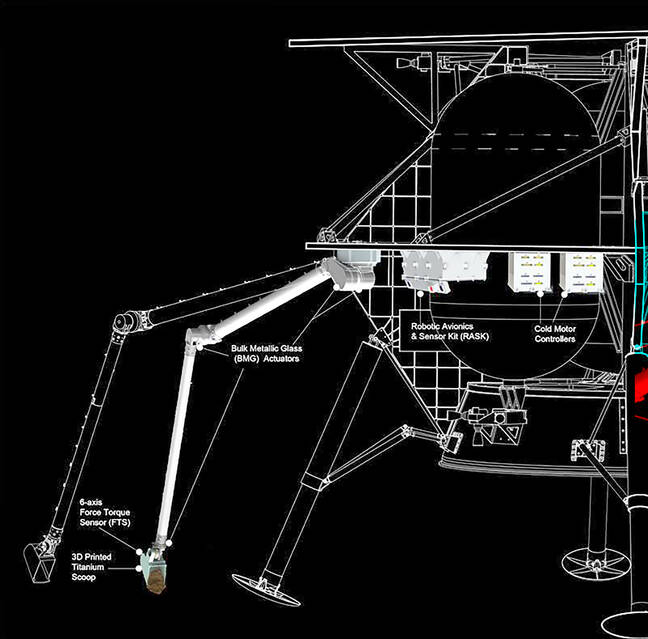This article is more than 1 year old
NASA's COLDArm robot limb can handle seriously cool science
Bofffins claim lunar manipulator is tougher than a Terminator
NASA is testing a new robotic arm that could revolutionize exoplanetary science for a reason most of us have probably never even considered: It doesn't need to be kept warm in order to work.
The Cold Operable Lunar Deployable Arm, or COLDArm, is being designed to operate on the south pole of the Moon, a focus of future lunar research and where future Artemis missions are expected to touchdown at some point this decade.
One problem: the Moon's South Pole gets colder than the surface of Mars, NASA said. NASA's current generation of landers and rovers all rely on onboard heaters to keep lubricant warm, parts moving, and motor controllers functional, and the bitter -280°F (-173°C) temperatures of the polar lunar night are simply too cold for such equipment to keep up.
The two-meter long COLDArm doesn't need to be kept as warm thanks to a combination of better materials, cold-resistant components and smarter tech. The result is a machine NASA said can cut two hours of preheat time off operations and could reduce daily energy consumption by up to 30 percent.
"COLDArm would let missions continue working and conducting science even in extreme cryogenic environments," said project principal investigator Ryan McCormick. COLDArm has already succeeded at tests of its ability to gather and process data; tests of the arm's ability in spacelike conditions are next on the agenda.
How to do science without losing your cool
There's no lubrication used to grease the parts that control the COLDArm. Instead, the gears are made of a material called bulk metallic glass, which is created by superheating metal to randomize its atomic structure, and then cooling it fast enough to harden it without allowing it to recrystallize.
McCormick referenced the film Terminator 2 where the machine is temporarily stopped when frozen in liquid nitrogen. "The bad guy can't work in those temperatures, but COLDArm could," he said.
Also called BMGs, the materials are prized for their high plasticity and remarkable strength, and have been used in plenty of applications since their discovery in the 1960s, from things like golf clubs to electronics. They also don't get brittle in cold temperatures, which make them ideal gears for COLDArm.
"Initial testing has demonstrated strong torque and smooth turning without lubricant, even at -328 degrees Fahrenheit (-200 degrees Celsius)," NASA said.
- You're getting warmer: NASA's thermal mole reveals active mantle plume on Mars
- After lunar orbit trip NASA's Orion capsule is on its way back home
- SpaceX grounds Falcon 9 carrying first private lunar lander
- Japan successfully propels steam-powered spacecraft
The second major component that gives COLDArm its capabilities is its cold motor controller, built by project partner Motiv. NASA said the controller can function at temperatures as low as 100 Kelvin (around -280°F or -173°C) – perfect for operations on the Moon's poles, Mars' frozen regions or even Saturn's moon Titan, where the climate is similar.
Because they don't need to be kept in the warm electronics box (WEB), the controllers can be installed closer to scientific instruments, further cutting down on insulation and cabling needs, and thus weight, too.
That's not to say there won't be heated components as part of the larger COLDArm assembly: it has a WEB, where the robotic avionics and sensor kit (RASK) will be housed, along with FPGA, communications and power boards, cameras and torque sensors.

A schematic of NASA's COLDArm with parts labeled.
Source: NASA/JPL-Caltech
The arm is capable of being guided or operating autonomously, and contains a few other bits of tech that NASA has developed for the Mars helicopter Ingenuity, including a similar processor and the F Prime open source flight software developed at NASA's Jet Propulsion Laboratory.
Artemis III, which isn't scheduled to launch before 2025, will be the first manned mission to the lunar surface since the halcyon days of the Apollo era, but COLDArm probably won't be aboard, unless NASA pushes Artemis III much further back. The arm isn't expected to enter service until the "late 2020s." ®
